 Museum
Museum  |
Bomber Command
|
Aircrew Chronicles
|
Aircrew Losses
|
Nose Art
|
BCATP
|
Lancaster
|
Media
|
Bomber Command
|
Aircrew Chronicles
|
Aircrew Losses
|
Nose Art
|
BCATP
|
Lancaster
|
Media
 Museum
Museum  |
Bomber Command
|
Aircrew Chronicles
|
Aircrew Losses
|
Nose Art
|
BCATP
|
Lancaster
|
Media
|
Bomber Command
|
Aircrew Chronicles
|
Aircrew Losses
|
Nose Art
|
BCATP
|
Lancaster
|
Media
Bomber Command Museum Archived Newsletters
 Download Printable Version
Download Printable Version
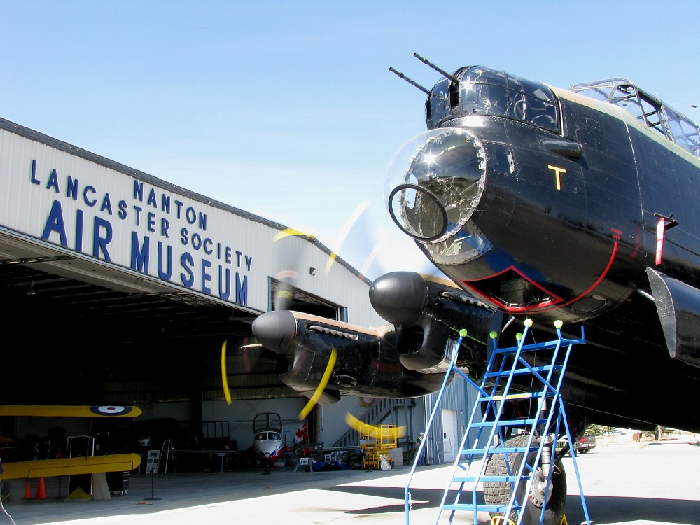
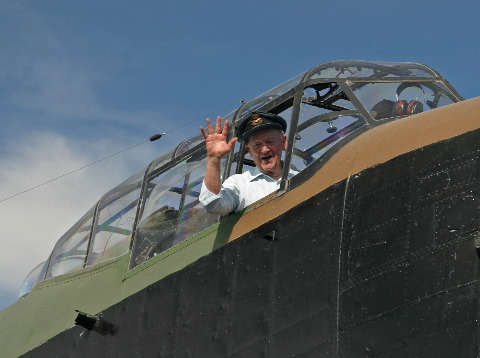
|
NLS founding member and former WWII Lancaster pilot, Joe English, passed on to his reward on January 10, 2010. Joe was active in the Society from its very beginning and was a supporter right up until his passing. He will be sorely missed by all those with whom he worked in establishing the Nanton Lancaster Society and the aviation museum that resulted. Joe English was instrumental in getting the Society started and had a hand in every facet of the development of what has just now become the Bomber Command Museum of Canada. |
One of the Society's long running events, the annual Fly-In, can be credited entirely to Joe. His promotion of having such an event has developed to the stage where sixty to eighty aircraft attend each year. The year 2010 is the eleventh anniversary of this event. The first, "Joe English Memorial Fly-In," will be held on July 17. This will be an extra special day. Please plan to attend. Joe English spoke at the 2008 dedication ceremony naming the museum's multi-media room in his honour. |
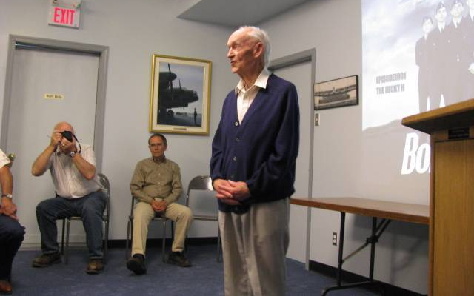
|
An example of engineering ingenuity inspired by the challenges of war, the De Havilland Mosquito's all-wooden design, was a major advantage during a time of acute shortages of light metal alloys. The sleek, Merlin-powered design, together with lightness and lack of any defensive armament or armour, allowed the Mosquito to travel at speeds in excess of 400 miles per hour to escape from enemy fighters. Designed as a bomber, the Mosquito could deliver the same bomb-load to distant targets as the heavily armoured, four-engined B-17 of the American Air Force. Mosquitoes served with Bomber Command in the Pathfinder Force and specialized in low-level precision raids. Others served in a night-fighter role. |

|
The Okotoks, Alberta, branch of Victoria Quilts Inc., a Canada-wide volunteer organization which make quilts to give to cancer victims undergoing chemotherapy, held its 2009 annual Quiltathon in the museum last May. They will be back again on May 1, 2010. This branch of Victoria Quilts has groups in several area towns, including Okotoks, Nanton, Black Diamond, Stavely, and one group in Calgary. Last year their combined efforts resulted in over 1000 quilts being sent out to patients taking therapy. The Nanton Lancaster Society is pleased to be able to assist this volunteer organization by donating room in the museum for the Quiltathon. |
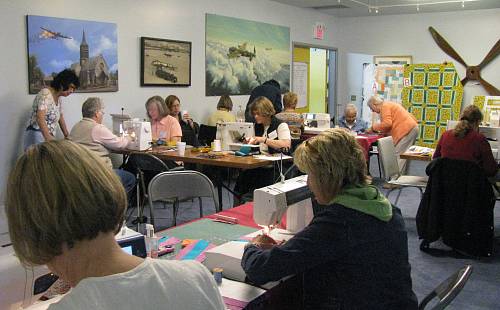 at the 2009 Quiltathon, held in the air museum. |
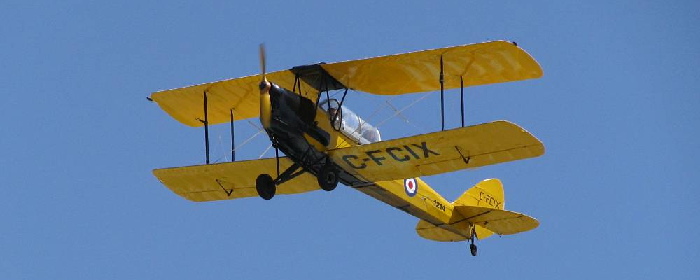
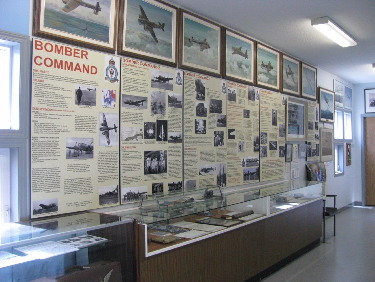
|
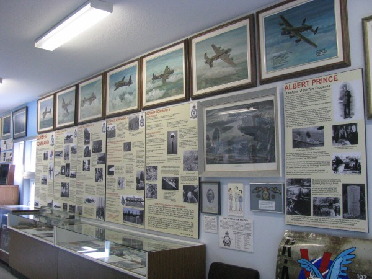
|

|
Along with the Bomber Command display up-grades, the panel for the display commemorating the loss of Sgt. Albert Prince, the first Canadian killed in action during WWII, was also renewed. It is now part of the overall Bomber Command display rather than being separated, as it was before. Along with these upgrades there are other changes to the displays making them much more visitor friendly. The upgrades to the Bomber Command exhibit and other displays is the work of museum board member, and volunteer library/archivist, Dave Birrell. He has spent a lot of time over the past six months revamping the text and incorporating new additional photos. |

|
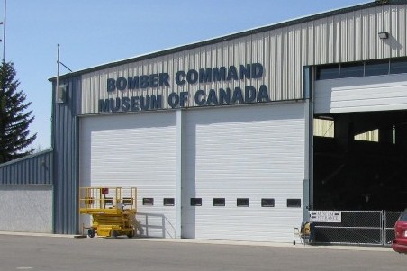
|
 Letters for new building signage were made "in house" by museum volunteers. |
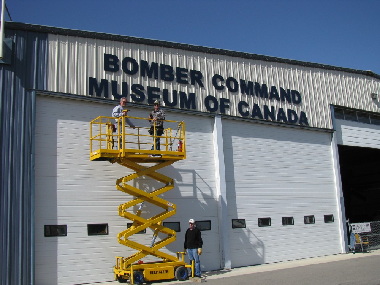 Dan Fox and Dennis Muldoon on the lift with Barry Beresford below have just finished installing the signage letters for the Bomber Command Museum of Canada. |


|
Members will recall that the Town of Nanton was "Twinned" with the Village of Senantes in France during our commemoration of the sixty-fifth anniversary of Ian Bazalgette's Victoria Cross Flight. On 28 November 2009, our friends in Senantes planted a "genuine Canadian Maple" tree to commemorate the Twinning. The Nanton Lancaster Society is planning to have a joint ceremony on August 4, 2010, with the Senantes officials. This will be to commemorate the sixty-sixth anniversary of S/L Ian Bazalgette's ill-fated wartime operation in which he lost his life in an failed attempt to land his flaming Lancaster to save the lives of his two injured crew members, thus posthumously being awarded the Victoria Cross. It is hoped that a phone connection will be in place with the Senantes officials as part of the joint ceremony in August. A Canadian Maple tree wa planted beside the Senantes church and near the grave of S/L Ian Bazalgette, commemorating the twinning of Senantes France with Nanton, Alberta, Canada in 2009. |
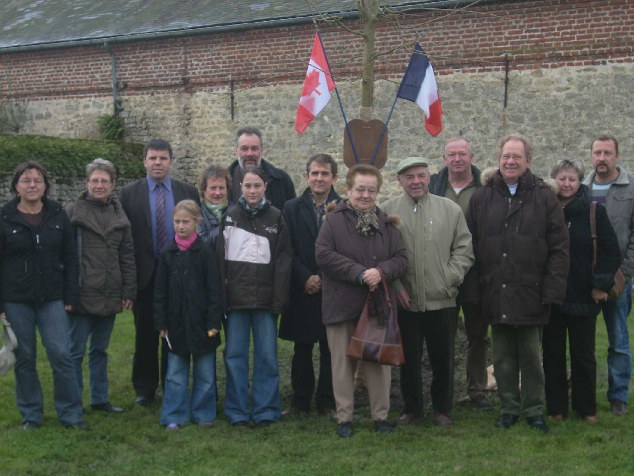
 Bob Evans and Neil Davidson stand amid the restored wings holding an aileron. |
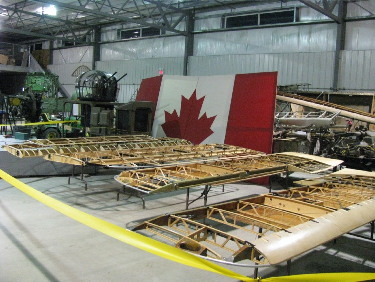 Restored Tiger Moth wings were delivered by Neil Davidson, owner of Davidson Aeroworks. |
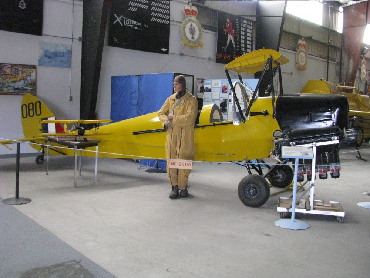 RCAF #1202 now carries the tail number 4080 which was the Moth flown by Murray Peden during his initial training at the High River, Alberta, EFTS. |
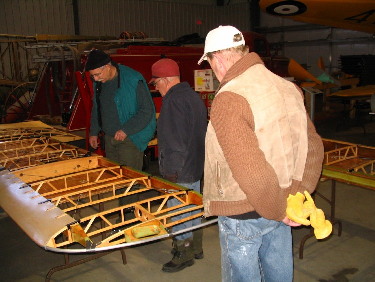 From L to R examining one of the restored Tager Moth wings: Neil Davidson, owner of Davidson Aeroworks, Kimberley, B.C., who restored the four wings, Bob Evans, NLS museum curator, and NLS board member, Barry Beresford looking on. |
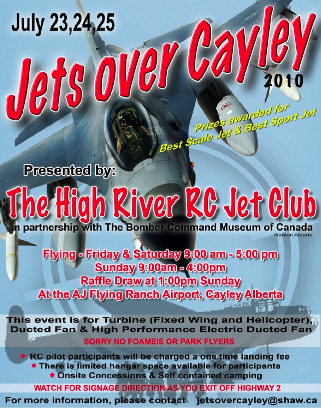
|
Members may wish to combine a visit to the museum with this exciting event that will be held at the AJ Flying Ranch, five kilometres east of Cayley, and just eleven kilometres north of Nanton. The event is for turbine (fixed wing and helicopter), ducted fan, and high performance electric ducted fan r/c aircraft. There will be a Lancaster engine run-up on the evening of the 24th for the participants. For additional details please visit the Special Events section of our website at: [ www.bombercommandmuseum.ca ] or contact [ jetsovercayley@shaw.ca ]. |
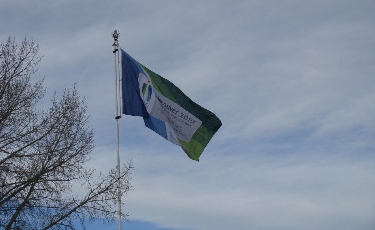 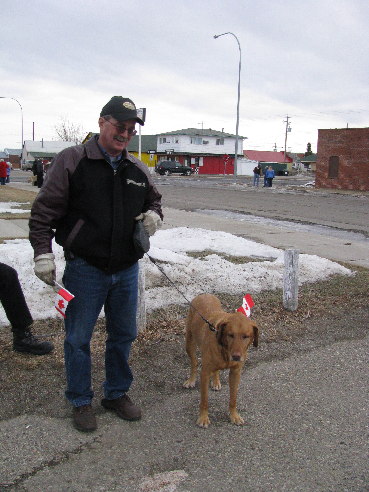 Both are in the spirit of the Olympics carrying Canadian flags. |
February 18 saw the Olympic torch run reach Nanton, Alberta. Our town was one of the communities through which the torch run was scheduled. Your air museum was involved in a small way. We flew the Olympic flag on the 100 foot flag pole (donated to the Society in 2009) during the week prior to and during the time the Olympics were being held in Vancouver. The museum also hosted the noon luncheon in the new hangar at noon. Lunch consisted of sandwiches and an Olympic cake, which was supplied by the local Olympic committee. 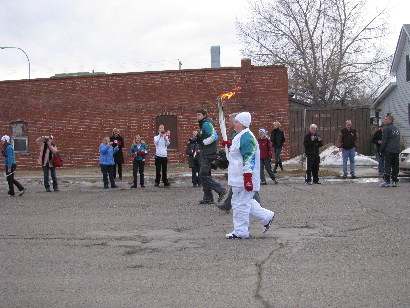 An Olympic torch runner passes near the meuseum on February 18. 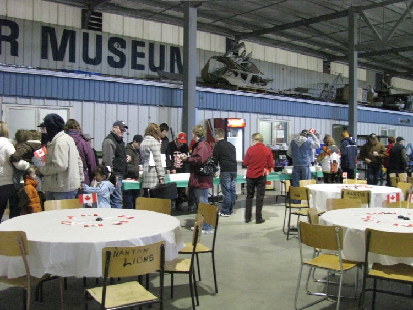 The local Olympic committee served sadwiches and "Olympic" cake in the Air Museum's new hangar. Tables were decorated with Olympic flags. |
|
The need for hands-on displays in the museum has been evident for a long time. While this has been brought to the attention of the directors, everyone has already enough things "on their plate." Your curator finally "took the bull by the horns" and contacted Education Director, Dave Heathcote, at the Alberta Aviation Museum in Edmonton. Dave has been building simulators for that museum for several years and is an expert in this phase of museum promotion. To make the story short, Dave offered to put together a simulator package for NLS. He had found a source of used computers and was able to quote a price that was within our budget. Curator Bob Evans had mentioned the need for such a display in the museum to his son-in-law, Lorne Herriman, who offered to help. Lorne has considerable computer knowledge. Once the simulator "package" was ready, Bob and Lorne travelled to Edmonton to pick up the components, with Lorne getting info on how the system worked. |
 until the Anson cockpit is made ready. |
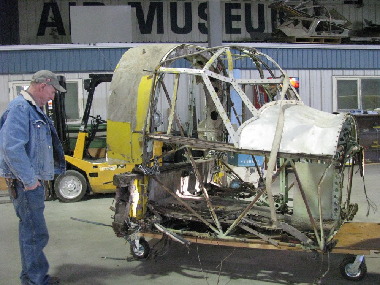 Volunteer Francis Gardner checks over the Anson Mk. V cockpit that is to be used to house the simulator components. He hauled it to the museum with his "picker" truck. |
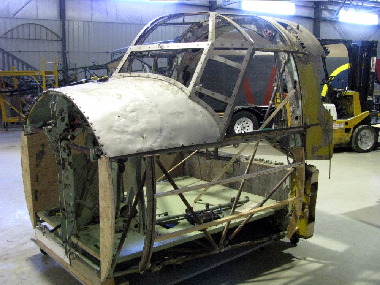 Anson cabin stripped and modified for installation of the simulator electronics and mounted on a castered base. |
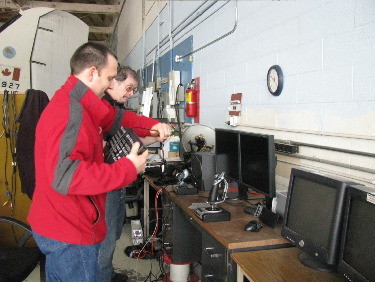
|
NLS extends a grateful THANK YOU to Dave Heathcote for sharing his expertise that made this display possible! THANKS also to Lorne Herriman for his great help! Lorne Herriman (foreground) and Alberta Aviation Museum, Education Director, Dave Heathcote, pack up the simulator components that Dave put together for NLS. |
In March, Jo-Anne Callbeck, of "Comp-U-Learn," contacted the museum looking for a space that had Internet access, in which to hold a computer class for persons in the Nanton area. The class was to run for ten days. The NLS board agreed that the Joe English Room could be made available for such a class and a fee was agreed upon. The class ended up with five students. The income from this came at an opportune time and helped to off-set winter heating costs. |

|
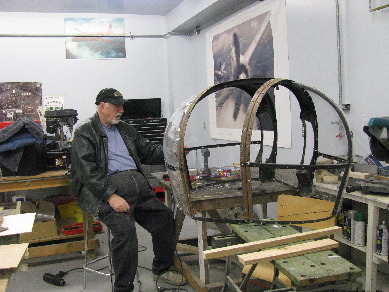 |
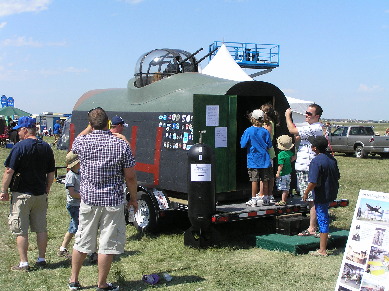 Both children and adults were intrigued with the gun turret. |
|
The Lincolnshire Aviation Heritage Centre, at East Kirkby, England, owners of the taxi-able Lancaster, NX611 (Just Jane), are in the process of upgrading their Lanc to an airworthy status. In March Ian Hickling and Andrew Panton from Lincs Aviation visited Nanton regarding the possible exchange of Lanc parts to the benefit of both our groups. NLS is getting two header tanks for Packard Merlin 224 engines and propeller vibration mounts in exchange for a Rolls Royce Merlin 24 header tank and other items. Your Society is pleased to be able help to Lincs Aviation in a small way to upgrade their Lancaster to flying condition. The trade of parts has also been of great assistance to the on-going restoration of Lancaster FM159. We wish Lincs Aviation all the best in making "Just Jane" airworthy. |
 Barry Beresford, Tink Robinson, Ian Hickling (UK), Rob Pedersen, Greg Morrison, Bob Evans, John Phillips. Behind sitting on a crate, Dan Fox, and Andrew Panton (UK). (the 2/3 scale Lysander is in the background.) |
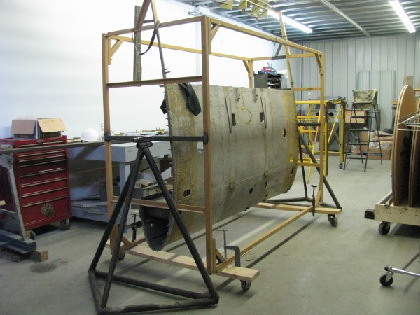 so it can be rotated. This will make the leading edge more easily accessable for the necessary repair work to take place. A new main spar and other components are now in the works. |
This long-term airworthy project has seen some action over winter. Our friend Marcus Stephenson is in the process of having new centre-section spars and associated parts made up to replace the originals. These components have been de-riveted and removed by volunteer Bob Long. The photo above shows the centre-section in its jig, with the spar removed. Some of the rib components are seen hanging from the ceiling above the jig. Marcus has also indicated that he hopes to have the restored, airworthy, rear fuselage painted and back to the museum very soon. We will then attach it to the forward fuselage tubing section and place it on display awaiting the completion of the centre-section. After that the outboard wings will become priority. |
Since the removal of Merlin #2 (Port Inner) on April 21, 2009, we have continued preparation work for the running of this, our third Lancaster Merlin engine. Various components of the engine were stripped off such as the fire extinguisher lines, miscellaneous hoses, etc. The engine was then power washed to remove as much as possible the grease, dirt, etc., that has gathered over the years. The carburetor and radiator were removed and inspected. We then left the Merlin in the shop while we concentrated on all other components on the airframe required to run the engine. Over winter we have done maintenance as required on number 3 and 4 engines - spark plug cleaning, checking oil filters, replacing leaking water pumps, etc. |

|
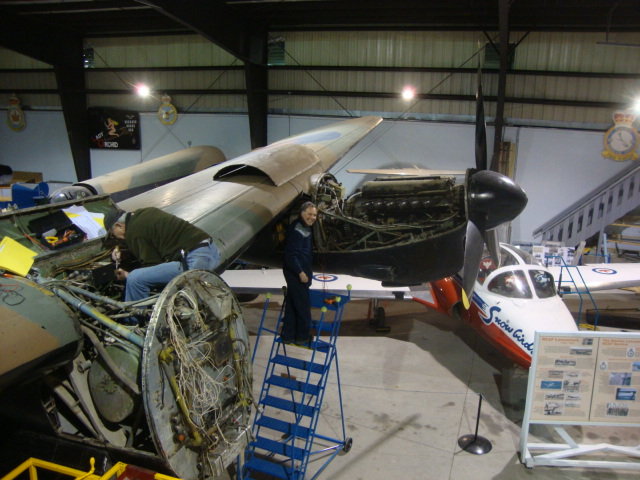
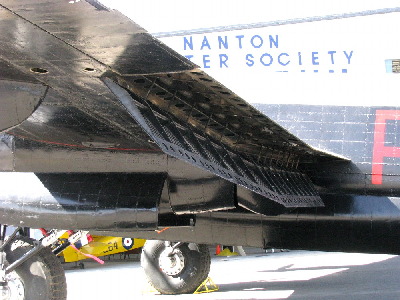 This photo shows the flaps in their full down position during the April 17 engine run, using the refurbished hydraulic system. |
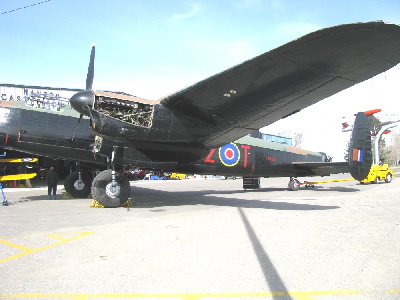 With the two Merlins running on April 17, the flaps were articulated. Here they are shown in the full up position. |
 The bomb bay doors are shown here fully open, testing the hydraulic system with the Lanc outside and the Merlins running in mid-April at the trial run to make sure everything was ready for the scheduled summer event run-ups. |
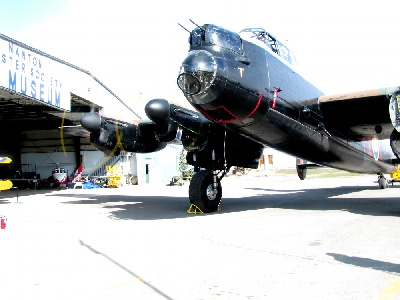 Bomb bay doors are shown here completely closed using the aircraft dydraulic system at the trial running of the Merlin engines on April 17. Closed dydraulically for the first time in sixty-some years. |
|
This is a special report to all of our members and supporters who believe in our unique and historic quest and wish to contribute to the Halifax Project. We are making good progress in our work to get a commercial contract for Deep Ocean Research Ltd. and the Polar Prince. When we have acquired this contract we will be able to "piggyback" our historic 2010 sonar survey on this commercial work to find RCAF Halifax LW170, off the coast of Ireland. Our next report will have more details on these activities. However, this special report is not about these diligent activities. This is an urgent appeal for contributions and funds to help bring back a large number of rare Halifax bomber components discovered in Europe to Canada's Bomber Command Museum in Nanton, Alberta, by Halifax 57 Rescue (Canada). This author, as the recon and point man, was advised of the parts by some Warbird friends of our cause. I hastily rallied our directors for a consensus and we all agreed we must acquire these parts for they are unique and absolutely vital to any future Halifax bomber rebuild. In our hour of discovery and financial need, a Canadian patriot and proud son of a Canadian veteran stepped forward to provide the funds to purchase these valuable Halifax parts. Clint Cawsey of Canmore, Alberta, was approached in February and given a full briefing on this great opportunity to acquire these unique Halifax parts. He was equal to our needs and donated the entire amount required to purchase the Halifax parts we had discovered. Talk about coming to the rescue and having faith in us! I see this now as "the beginning of our real beginnings" thanks to Clint's vision and timely generosity to our cause. 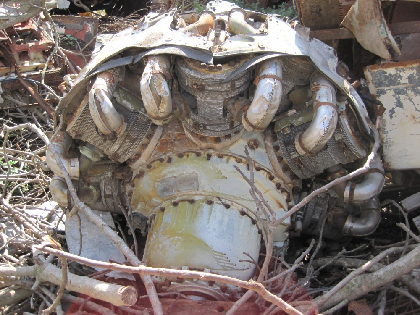 One of the Halifax Bomber "Finds" from Europe. |
 Shown here is one of the recently located Hercules engines. It, along with another engine and wing sections, are part of the Halifax bomber/Hastings transport aircraft parts recently found in Europe. But, we are not out of the woods yet. We must ship these parts from Europe to Nanton, Alberta. We need your help, my friends, to provide the funds to help pay for the shipping costs of a container across this great distance. The shipping costs could be $10,000 - 12,000. The acquisition of these parts will be a huge step toward our ultimate goal to have a Halifax at Canada's Bomber Command Museum. Your assistance is needed! Look for an announcement of a major Halifax/Hastings airframe find in both the NLS and Halifax 57 Rescue websites in May 2010. |
 |
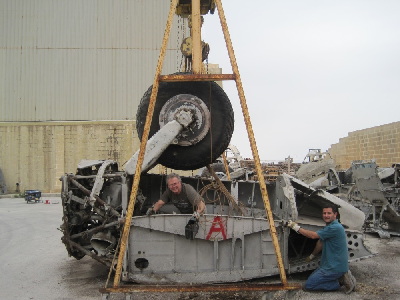 Mario, getting the Halifax/Hastings wing center-section (c/w undercarriage leg and wheel) ready to move from the scrap yard. |
This report marks a special milestone in the restoration of "Annie." In February the restoration of the Cockpit floor was finally finished and with the last drop of paint applied the floor was finally installed into Anson "7481. After just under two years of restoration, the occasion was marked by the Anson crew with champagne and sparkling ginger ale. They say a picture is worth a thousand words so I'll let the following pictures tell the tale of the floor and how it went from "fire-wood" to a living piece of history. The floor when restoration began - Note that the floor was missing sections and had been cut right in half along the length of it. At this point in time it was hard not to look at it as anything more than "fire-wood." |
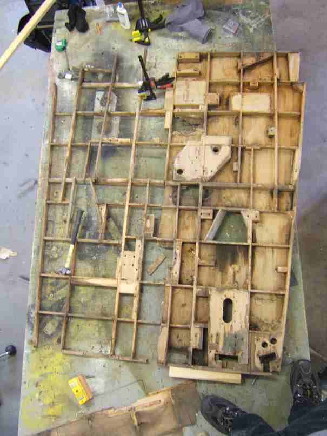
|
 Missing pieces are replaced. Three partial floors were used to produce one fully restored floor.  The floor, with the bottom attached, now waits for the top covering to be installed. 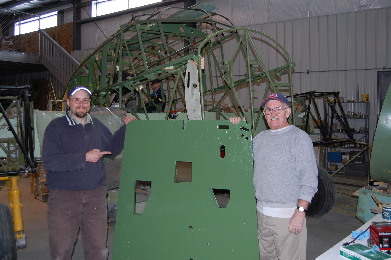 Charles Logie and John Maze pose with the completed floor, just moments before it is installed in Annie. |
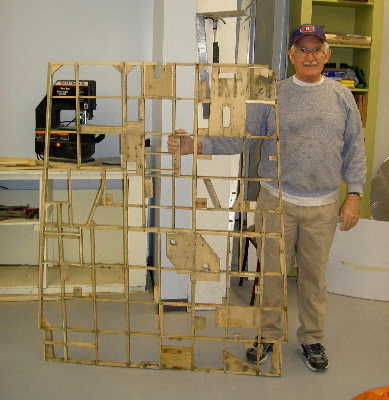 John Maze is the man responsible for the restoration and the completed frame work. The floor is now ready for the top and bottom covering. 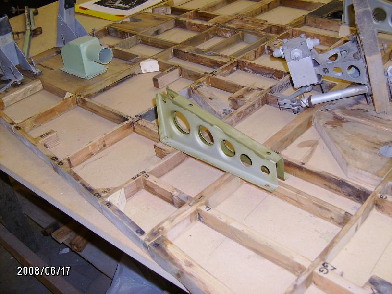 Components that will later be mounted to the floor are placed on top to make sure that all the necessary wood has been added back. There will be no opportunity to do so once the covering is added. 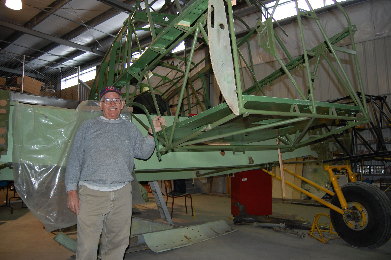 John Maze smiles now that the floor is located in its new home. |
 The 2/3 scale Lysander has been in the new hangar during the winter months with the brakes and engine being upgraded. It is hoped to have the egine run-able for the events this summer. |
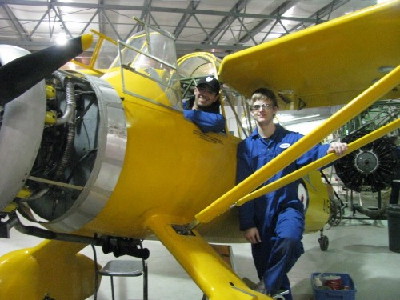 Two of the second year SAIT students, Bruno and Richard, working on the Lizzie. |
 Repairs to the vertical fin are underway. |
 A Ranger engine that has been stored for some time in Calgary. It will replace the cut-away training engine that is presently on the museum's Fairchild Cornell. |